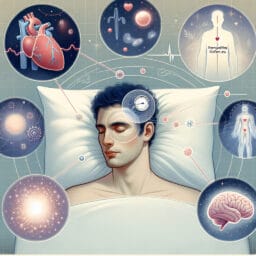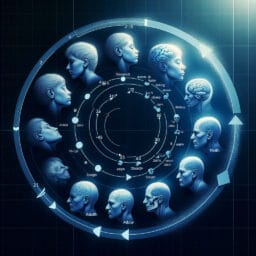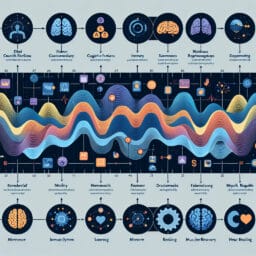Unraveling the Mysteries: A Comprehensive Guide to Define REM Sleep
Table of Contents
- Introduction
- Understanding Sleep
- Diving Deeper into REM Sleep
- The Connection Between REM Sleep and Dreams
- The Impact of Lack of REM Sleep
- How to Improve REM Sleep
- Conclusion
- Frequently Asked Questions
Introduction
A surprising fact is that during REM sleep, your brain activity is remarkably similar to when you’re awake. This stage of sleep, characterized by rapid eye movements and increased heart rate, plays an important role in numerous aspects of your health and well-being. As the “dreaming” phase of the sleep cycle, REM sleep contributes significantly to emotional regulation and memory consolidation. It’s during this REM stage that experiences and information from the day are processed and integrated into our long-term memory.
But it isn’t just about mental health; REM sleep also aids in physical rejuvenation. The nervous system repairs itself, supporting healthy brain development while the immune system gets bolstered for optimal function – a vivid testament to how interconnected our bodily systems are! Moreover, research has suggested links between depriving yourself of quality REM sleep time and various neurological disorders or sleep-related issues like insomnia and sleep apnea.
Understanding these components can help you appreciate why maintaining a regular bedtime routine aimed at ensuring enough total sleep time – particularly deep, restorative REM stages – is vital. Sleep medicine specialists emphasize that disrupting normal cycles with inadequate light or deep ‘slow-wave’ non-REM (NREM) stages can adversely impact both cognitive function and general health. So next time you’re tempted to skimp on your zzz’s remember – adequate shut-eye encompasses more than just falling asleep; it includes nourishing all your critical sleep states too!
Understanding Sleep
Our sleep journey each night unravels in a series of cycles, with REM sleep playing a pivotal role. As we doze off, our brain activity gradually decreases from the light NREM sleep stages into deep sleep or slow-wave sleep. It’s in this rejuvenating deep-sleep stage that significant body repairs occur and our immune system strengthens. But it’s with the transition into the paradoxical REM sleep phase where things get fascinating! Flickering under closed lids are rapid eye movements, while heart rate and breathing mimic wakefulness; our brain waves echo patterns akin to when you’re awake – a cerebral ballet of sorts that constitutes an entire REM cycle.
During these captivating REM phases, your brain is bustling with activity, processing events of the day and consolidating memory. Despite muscle tone being at its lowest ebb — rendering us virtually paralyzed to prevent acting out dreams — the mind is electric as visual cortex stirs up vivid dreamscapes! Sleep disorders such as insomnia and sleep apnea often interrupt this intricate dance between non-rem and rem stages of the sleep cycle, potentially causing neurocognitive issues over time.
Scientists have found that adult humans spend roughly 20-25% of their total sleep time in REM stage; emphasizing its crucial role in mental health maintenance, brain development, emotional regulation among others. So next time you curate your bedtime routine or tweak your nutritional therapy for better wellness outcomes remember this – quality of “sleep” isn’t just about clocking hours but respecting all critical components–from light NREM to deep slow-wave slumber to vibrant REM stage–of your unique odyssey through unconsciousness every night.
| Stages of Sleep Cycle | Description | Functions |
|---|---|---|
| NREM Sleep Stages | The initial stages of sleep where brain activity gradually decreases from light sleep into deep sleep or slow-wave sleep. | Significant body repairs occur, and our immune system strengthens. |
| REM Sleep Stage | Distinguished by rapid eye movements under closed lids, heart rate and breathing mimicking wakefulness, and brain waves echoing patterns akin to wakefulness. | Brain processes events of the day, consolidates memory, and stirs up vivid dreamscapes. Muscle tone is at its lowest, preventing acting out dreams. |
| Sleep Disorders (e.g. Insomnia, Sleep Apnea) | These interrupt the intricate dance between non-rem and rem stages of the sleep cycle. | Potentially causes neurocognitive issues over time due to disruption of sleep cycles. |
| Adult Humans’ REM Sleep Time | Scientists have found that adult humans spend roughly 20-25% of their total sleep time in REM stage. | Plays a crucial role in mental health maintenance, brain development, emotional regulation among others. |
Diving Deeper into REM Sleep
Unique characteristics distinguish REM sleep from the other stages of our sleep cycle. While we’re asleep, REM stage comes alive with a flurry of brain activity, mirroring patterns akin to wakefulness. Rapid eye movements flicker under closed lids and heart rate increases echoing the rhythm of alertness. However, in contrast to this mental arousal, our muscle tone reduces to its least during REM phase – an evolutionary protection mechanism preventing us from physically acting out vivid dreams induced by active visual cortex.
Indeed, the influence of non-REM and REM sleep extends far beyond nocturnal hours into our daytime activities and performance. The quality sleep offered by these stages is not just about total sleep time or falling asleep; it plays an important role in maintaining mental health. During “paradoxical” deep-sleep stage, significant body repairs occur and immune system strengthens. In contrast, during rapid-eye-movement (REM) phases, brain development accelerates as information from the day is processed and integrated into long-term memory.
Sleep deprivation or disruption caused by disorders such as insomnia or sleep apnea could lead to neurocognitive issues over time due to interrupted NREM and REM cycles. Hence it’s vital for individuals to maintain regular bedtime routines that respect all crucial components –from light NREM stage through deep slow-wave slumber, reaching vibrant REM stage – ensuring they fall asleep peacefully every night.
The Connection Between REM Sleep and Dreams
It’s fascinating to delve into the intriguing relationship between REM sleep and dreaming. As we drift into the realm of dreams during our sleep cycle, it is largely during the REM stage that our brain waves dance with fervor, painting vivid dreamscapes across our unconscious minds. Interestingly, the rapid eye movements – a signature characteristic of this stage – are often correlated with dream content. Science reveals that while various elements of sleep — rem or non-rem stages — aid in body repairs and bolstering the immune system, it’s during these periods of heightened brain activity in REM phases where most dreams unfold.
Renowned neurologists’ studies show us how disruption in this intricate relationship due to sleep disorders like insomnia or sleep apnea can negatively impact mental health over time. They emphasize how crucial these seemingly passive moments when ‘you’re asleep’ truly are for cognitive functioning and emotional balance; underscoring not just quality sleeping hours but more so quality engagement within each phase – light NREM through deep slow-wave slumber to animated REM stage.
Thus, understanding these unique interactions between different components of our nightly rest schedule – from the calm descent into non-REM deep sleep, through paradoxical REM episodes with rapid eye movements cloaked under closed eyelids and an active visual cortex brewing dreams – becomes instrumental in maintaining optimal neurological health. After all, every aspect from falling asleep peacefully to encouraging essential REM cycles plays an important role in shaping our waking life experiences too!
| Subject | Description |
|---|---|
| REM Sleep | It’s during the REM stage of our sleep cycle that our brain waves dance with fervor, painting vivid dreamscapes across our unconscious minds. The rapid eye movements associated with this stage are often correlated with dream content. |
| Role of REM Sleep | While various elements of sleep aid in body repairs and bolstering the immune system, it’s during the periods of heightened brain activity in REM phases where most dreams unfold. |
| Impact of Sleep Disorders | Disruption in the intricate relationship between REM sleep and dreaming due to sleep disorders like insomnia or sleep apnea can negatively impact mental health over time. |
| Importance of Quality Sleep | Quality engagement within each phase of sleep – light NREM through deep slow-wave slumber to animated REM stage – is crucial for cognitive functioning and emotional balance. |
| Interactions Between Sleep Components | Understanding interactions between different components of our nightly rest schedule becomes instrumental in maintaining optimal neurological health. Every aspect from falling asleep peacefully to encouraging essential REM cycles plays an important role in shaping our waking life experiences. |
The Impact of Lack of REM Sleep
When plunging into the realm of REM sleep, it is essential to uncover its profound significance in our overall health and well-being. Notably, interruptions in our sleep cycle — particularly a lack of REM sleep — can lead to detrimental effects on both physical and mental health. Sleep deprivation, particularly when it disrupts the rhythmic dance between non-REM and REM sleep stages, can lead to a myriad of neurological disorders. An under-appreciated fact is that during REM phase, despite muscle tone being at its lowest ebb – an evolutionary protection mechanism preventing us from physically acting out dreams – there’s intense brain activity akin to wakefulness. These paradoxical characteristics of REM sleep enable vital nervous system repairs and crucial brain development focused on memory consolidation and emotional processing. Therefore, depriving oneself from this restorative deep sleep stage could potentially impair long-term memory storage or even trigger mood imbalances. Moreover, persistent interruptions in your bedtime routine that compromise quality REM cycles could exacerbate sleeping disorders like insomnia or sleep apnea over time; underscoring the dire need for protecting your precious hours of shut-eye. Thus, understanding this delicate balance within our unique slumber schedule – from light NREM stages through vibrant periods of rapid eye movements in REM phases – becomes paramount for achieving optimal wellness outcomes.
How to Improve REM Sleep
In the realm of sleep science, one can’t stress enough the critical role REM sleep plays in shaping our overall well-being. This intricate stage of sleep, characterized by rapid eye movements and brain waves buzzing with activity, works towards essential nervous system repairs and crucial brain development. It assists in memory consolidation while also playing a pivotal part in emotional processing. These are but few among the plethora of functions that this paradoxical phase performs while we’re asleep – our body at rest but mind lively awake!
Yet, modern lifestyle changes often disrupt this delicate equilibrium within our sleep cycle leading to reduced total sleep time or even chronic sleep deprivation. An effective bedtime routine is an invaluable first step towards safeguarding your quality sleep hours. Try maintaining consistent sleeping and waking times; decrease exposure to electronic devices before bed as it could potentially interfere with your natural circadian rhythm; ensure your bedroom is conducive for rest—dark, quiet, cool—with comfortable bedding.
Moreover, nutritional therapy focusing on balanced meals rich in magnesium (found in leafy greens), tryptophan (in turkey or milk) or melatonin-producing foods like cherries could encourage healthier REM cycles. Regular physical activity has been shown to enhance deep slow-wave NREM stages transitioning into restful REM periods more efficiently; so ensure you incorporate some form of exercise into your daily schedule.
But remember – if persistent issues persist despite lifestyle modifications it might indicate underlying neurological disorders or other health concerns disrupting your normal REM patterns such as insomnia or sleep apnea. Consulting a professional from the field of Sleep Medicine could provide suitable medical treatments tailored specifically for improving REM stage quality–from cognitive behavior therapies to medications addressing specific disruptions like nightmares linked with post-traumatic stress disorder (PTSD). After all, each component from falling asleep peacefully through light NREM stages into vibrant REM phases ensures not just rejuvenation after a day’s work but long-term mental health stability too! So take charge today – because when it comes to sleep, quality truly matters above quantity.
Conclusion
Unveiling the intricacies of REM sleep and its unique components reveals a fascinating aspect of our well-being influenced by this paradoxical sleep stage. As we journey through various sleep stages each night, our brain waves oscillate, echoing an interactive rhythm that’s integral to both physical rejuvenation and cognitive performance. It’s remarkable how during REM sleep phases your mind — buzzing with activity akin to wakefulness — consolidates memories while simultaneously orchestrating essential nervous system repairs which are vital for optimal brain development. This bustling cerebral orchestra juxtaposed against a backdrop of minimal muscle tone paints a vivid image of the REM stage – a distinct element within our complex sleep cycle.
The interplay between non-REM and REM stages profoundly governs not just your nightly repose but also shapes daytime functioning. The restorative power wielded by quality sleep in fortifying the immune system, enhancing emotional regulation, or even boosting mental health resonates beyond mere total sleep time; it underscores the importance of nurturing each phase from light NREM slumber to deep slow-wave rest before plunging into vibrant rapid eye movement-laden REM cycles.
Yet, modern lifestyle changes often disrupt this delicate nocturnal equilibrium leading to unprecedented levels of chronic sleep deprivation which could exacerbate existing conditions like insomnia or instigate other neurological disorders. A mindful approach towards maintaining consistent bedtime routines coupled with balanced nutritional therapy can significantly improve quality of rest and maximize benefits derived from enhanced REM phases in particular.
In conclusion, understanding and respecting each component—including rem phase—within our unique unconscious odyssey is crucial for optimizing regeneration processes performed during deep sleep stages thus ensuring robust overall wellness outcomes. So delve deeper into exploring this realm – because when it comes to understanding the importance of REM Sleep – every flickering eye movement counts!


